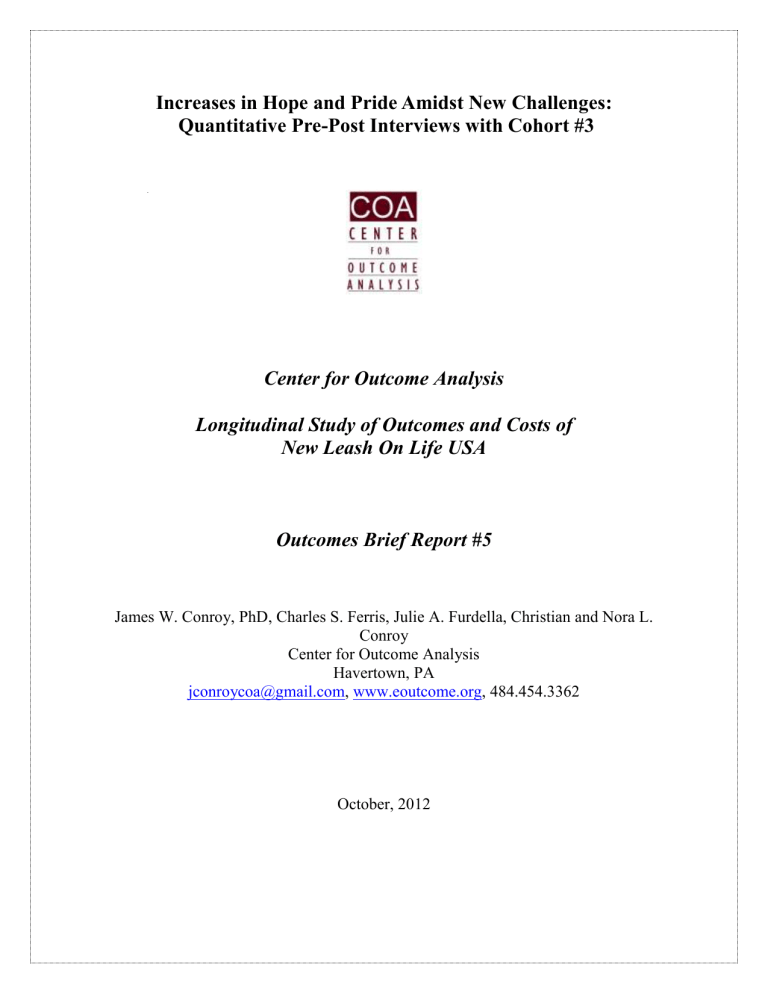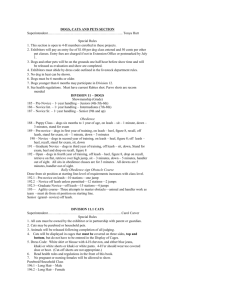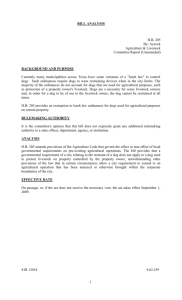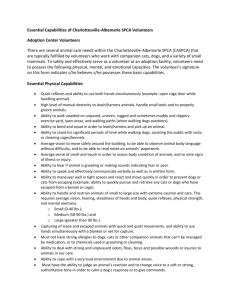Increases in Hope and Pride Amidst New

Increases in Hope and Pride Amidst New Challenges:
Quantitative Pre-Post Interviews with Cohort #3
Center for Outcome Analysis
Longitudinal Study of Outcomes and Costs of
New Leash On Life USA
Outcomes Brief Report #5
James W. Conroy, PhD, Charles S. Ferris, Julie A. Furdella, Christian and Nora L.
Conroy
Center for Outcome Analysis
Havertown, PA jconroycoa@gmail.com
, www.eoutcome.org
, 484.454.3362
October, 2012
Quantitative Pre-Post Interviews: New Leash Participants Report
Increase in Hope and Pride Amidst New Challenges
Introduction
The Center for Outcome Analysis has completed the first “before and after” study of the reactions of participants in a canine training program in an urban jail.
1
Our results are given here in short and nontechnical form.
This report is one of a series of Outcomes Reports, both brief and detailed. The previous brief report was similar, but used the memories of the participants to recall how their lives changed,
2
while this one uses data from interviews “before and after” the ten weeks of training provided by New Leash experts.
According to the author of the only book on this topic, past studies have been qualitative and/or anecdotal (Furst. 2011) 3 . Scientific studies of participant reactions, changes, and outcomes are needed. The study reported here is the first to measure outcomes using “Pre and Post” survey data. The sample is small (12 men), but we do have a comparison group of 12 otherwise similar men who were not involved in the program, and that adds a level of scientific credibility.
4
1 New Leash on Life USA ( http://newleashonlife-usa.org
) was founded in 2010 primarily as a way to save dogs, particularly pit bulls, from destruction. By the time the first cohort of participants began training, New Leash was also aimed strongly at benefiting the participating men, but teaching them concrete skills that might be useful postrelease/
2 James W. Conroy, PhD, Steven J. Devlin, PhD. Charles S. Ferris, and Nora L. Conroy (2012, October). New Leash
Participants See Their Lives Improving . Report 3 of a series in the Outcomes Brief Reports on the Philadelphia New
Leash on Life USA program as part of the Longitudinal Study of Outcomes and Costs of New Leash On Life USA.
Havertown, PA: Center for Outcome Analysis.
3 Furst, Gennifer (2011). Animal Programs in Prison: A Comprehensive Assessment . Boulder, CO: First Forum
Press.
4 The Comparison Group results were as expected, basically no major changes, and will not be reported here for the sake of brevity.
2
We conducted interviews with the men who volunteered for the New Leash prison pilot project just before the beginning of their involvement, and again right at the end.
We used a standardized survey derived and adapted from many surveys used in past prison research.
5
The New Leash program was a “live-in” design, in which six dogs rescued from imminent euthanasia were placed with twelve inmates of the Philadelphia city jail’s
Alternative Sentencing and Detention Unit for ten weeks. The men received training in dog behavior, care, and health. They learned how to retrain the dogs to be obedient, gentle, and affectionate. The training was intended to make the dogs into “Canine Good
Citizens,” and they were tested at the end of the ten weeks by certified experts. The dogs were then offered for adoption. The men were also considered tested, by the behavior of their dogs, and were awarded certificates if successful.
Results
The results of this outcome study were analyzed and graphed.
6 Survey questions were grouped into five general categories: Prison Conditions, Emotions, Feelings About
Self, Emotions, Relationships with Other Inmates, and Relationships with Staff. The numeric results are shown graphically below.
5 The instrument is available from the lead author of this Outcomes Brief Report at jconroycoa@gmail.com
.
6 As a formality, they were also tested for statistical significance at the p<.05 level.
3
Figure 1: Participant Ratings of Their Lives – “Pre and Post” Method
2.55
Prison Conditions *
2.03
Emotions
Feelings About Self
3.78
3.94
4.02
4.13
Inmate Relationships
3.05
2.95
2.98
Staff Relationships *
2.28
1.50
2.00
2.50
3.00
3.50
4.00
4.50
5.00
POST PRE
In the graph, the darker red bars on top show the “Pre” ratings (the men’s ratings of how things were before their dogs arrived), and the lighter blue bars at the bottom show the “Post” ratings, collected near the end of their time working with the dogs.
Although statistics are not strictly necessary in this situation, 7 they can be useful in giving us a clue to interpretation – namely estimating which of the changes from Pre to
Post is big enough to be considered “real.” Only two of the five scales showed significant
7 Inferential statistics are intended to tell us whether what we see in a sample is likely to be true for the entire population. Here, we have the entire population – 12 men – and we do not claim to be generalizing to a larger group.
In that sense, what is seen in the graph are the results, and no statistics are strictly necessary.
4
change, and they are marked in the graph by asterisks: “Prison Conditions” and “Staff
Relationships.” Both ratings went down, not up.
This meant that the participants rated their lives as “worse” than before in their general living conditions. Example items are “You can keep clean and decent here if you want to,” “You sleep well at night,” and “There is privacy here.”. They also rated their relationships with the Corrections Officers 8 had become less positive. Examples of these items include “Overall, you are treated fairly by staff here,” “You are encouraged to work towards goals here,” and “You can earn trust from the staff here if you want to”).
Because this was unexpected, we went deeper into the survey data, and found that there were three large changes in a positive direction among the men:
Over the past 30 days you have been feeling hopeless ?
Over the past 30 days you have been feeling depressed ?
Over the past 30 days you have been feeling proud of what you’re doing ?
These three improvements in the feelings of the participants suggested that, while relationships with the COs and general conditions became more demanding during the canine training weeks, the men felt better about their lives in some very important ways.
The fact that there were three dimensions in which scores did not go down was intriguing, as well. Normally, one would expect that if prison life conditions and staff relationships get “worse,” then emotions, self-concept, and relationships with other inmates would go down too. They did not go down. This suggested that in this unique situation with canines introduced into the environment, the inner feelings of the participants were unharmed by the negative aspects of moving.
8 Called simply “staff” in our survey.
5
Discussion
The first negative finding about living conditions – general prison conditions – may be easily understandable. First, the participants were transferred to a new cell block a day or two before the dogs arrived, and had to adjust to a new cellmate, new staff, and the dogs, all at once. Sleep was interrupted by the dogs quite often, and needless to say, keeping cells clean and odor free required effort. Privacy would also be reduced in many ways.
9
Yet in our previous study (footnote 2 above), the results were different. In that study, participants were asked at the end of the ten weeks to remember how they felt at the start, and how they felt at the end. Those results were almost all positive. We are not sure why the results are different, but the current “pre and post” method is favored by most scientists over the memory methods.
The second negative finding was unexpected, because past studies have reported improved relationships with staff, and even reduced incidents and violence. We have consulted other experts and discussed possible explanations – and hindsight is helpful too. Though we cannot be certain until more studies have been done, particularly longer lasting ones, at least we can offer ideas. It is possible that these ideas will prove useful in improving the New Leash program, via deeper understanding of the challenges involved, among prison officials, corrections officers, participants, and trainers.
Combining our qualitative research, which included open ended interviews and invited general comments and stories, with our quantitative surveys, enables us to give an informed “guess” about why ratings of relationships with staff went down.
9 Including visits, tours, and researchers doing observation and interviews – not to mention the keen interest of the other inmates and the Corrections Officers.
6
First, the men moved from an area they had been in for a while into a brand new situation where corrections officers and inmates had to start all over with the prison patterns of authority, discipline, and order. Our research method was to interview participants in their “old” cell blocks, before they moved to the New Leash living unit.
They rated their “Pre” relationships with staff there – where they had been for an average of about six months, and had adapted to the workers and their styles. They had in many and perhaps most cases reached some level of “comfort,” such as it was, with the authoritarian styles and personalities of the officers.
Then they moved to the New Leash block, and had to “start over” with new staff.
This is not unusual. Many of the men had probably been transferred before, and had to go through this process of learning new styles and rule interpretations. But here a radically new element was added: rambunctious and largely undisciplined dogs. The corrections officers’ primary job duty is often described as keeping order, so they were surely challenged by the new men and the new canines. So in addition to the change itself, there were entirely new needs for staff to quickly get control and keep the cellblock in line.
Finally, detailed interviews with both participants and corrections officers revealed an honest perception that some officers were not supportive of the presence of the dogs at all. Instances of exertion of authority with unusually small provocation were reported as frequent.
If the results of this “pre and post” study of participant attitudes are accurate, and if the perceptions reported in our in-depth interviews are also accurate, then a strong conclusion would be that the New Leash program might greatly benefit from more preparation. Prison officials would have to help figure this out, but the goals would be to get more support from the officers, prepare the men for their move a bit better, and generate a “let’s save these dogs together” atmosphere. This might replace the attitudes
7
we seem to have measured which included “the officers are tough on us” from one side, and “these dogs are just getting in the way of discipline” on the other.
These results suggest that the canine program did not result in dramatic improvements in qualities of life while the participants were still incarcerated. We must wonder whether this finding could be changed with better preparation of both the participants and the correctional officers. If so, another round of pre and post interviews would show different results.
It seems possible that what we measured in this study was to some degree a
“transition effect.” The introduction of the dogs was mixed with the change in living units and staff. The two things were both affecting the living situations of the participants, and it is difficult to say which was dominant.
If the original outcomes “theory” (that living situations and inner feelings would improve) has not yet been realized, then we believe it becomes even more important to talk with the participants after their release. Only in this way will we be able to determine whether the program had any impact on re-entry. Ultimately, it is the prevention of recidivism that will influence how the public and policy makers will judge the program’s value.
In the broader context of animal programs in prison, in which there is a great deal of interest in the City, the Commonwealth, and the entire nation, it may be very important to promote realistic expectations: doing these innovative and potentially beneficial programs is not easy. In Philadelphia, the New Leash program has enjoyed remarkable and consistent support from the top. Sometimes it takes a small extra tweak to make sure the policy reaches the front lines with complete and unquestionable clarity.
8
7 return to jail, about $35,000 per year and for a lifetime is “saved” from the taxpayers’ coffers.
And for each man who becomes gainfully employed and pays taxes, between $0 and $5,000 in taxes paid is contributed to society. On top of that, the benefit of the man’s entire salary can be attributed by accounting methods as a positive contribution to the local economy. Careful economists will also want to estimate the savings from crimes not committed, arrests not made, district attorney and public defender time not spent, and trials not held. There are intangibles far beyond those that can be “costed out,” as well, such as improved family life and enhanced child rearing when fathers are present as children grow rather than imprisoned.
We will gladly turn over all records and follow-up leads to the next scientific team to get involved with New Leash on this critical follow-up mission.
9
References
Furst, Gennifer (2011). Animal Programs in Prison . Boulder, CO: FirstForumPress.
10
Appendix: Outcome Evaluation Instruments
11
426B Darby Road
Havertown, PA 19083
Phone: (610) 668-9001
Fax: (610) 668-9002
Informed Consent Form: New Leash on Life Outcome Studies
TITLE OF THE PROJECT:
New Leash on Life (NLOL): Outcome evaluation of a dog training program for inmates
PURPOSE
The purpose of this evaluation is to find out about the New Leash on Life prison dog training program. The goal is to learn how inmates and staff feel about the program and how it works for them.
You have been selected by the Alternative and Special Detention (ASD) social work department because you are: 1) in the ASD Unit at the Philadelphia Jail system, 18 years or older; can speak and understand English, have no history of animal abuse, are not being discharged in the next few months, and are a participant in the
New Leash on Life dog program; 2) If you are a Philadelphia Prison system employee, you are being asked to be in this study because you are either an officer with the Alternative and Special Detention Unit, or an administrator of this unit. If you are not your own guardian, or have a primary diagnosis of Mental Retardation, or organic brain syndrome, you cannot participate in this study.
INVESTIGATOR
Principal Investigator: James Conroy, Ph.D., Center for Outcome Analysis, Inc., 426 B Darby Road,
Havertown, PA 19083.
The interview you are being asked to do is part of a program evaluation (research) project.
If you have any questions about this research you can call Dr. Conroy at 610 668 9001. If you have any problems during the study you can ask Dr. Conroy any time.
DESCRIPTION OF THE PROCEDURES
If you decide to be in this study, you will be one of about 12 inmates or 6 ASD staff in this study.
By consenting to participate, you agree to do four 15 minute interviews, two early in the project, and two at the end. We will also ask to interview you between 3 and 6 months after your release. The interviews will be done face to face. Parts of the interviews will be audio recorded. If you choose to participate you will be asked to speak freely about the NLOL program and yourself.
POTENTIAL BENEFITS
This study seeks to learn about your opinions and experiences with the New Leash on Life dog program. By participating you may think more deeply about how this program has affected you and/or your environment.
12
You might not benefit from being in this study. Other people in the future may benefit from what the researchers learn from the study.
Your participation in the program will not affect your sentence or services.
RISKS AND DISCOMFORTS
One risk to taking part in this study is that you may be asked questions that you may feel are personal. You do not have to answer a question if you do not want to.
If during the interview you tell us that you feel unsafe, threatened, or suicidal, we will report that to people who can help.
Second, there is always a risk of loss of confidentiality when personal data are collected. However, the study team will take steps to make sure that this will not happen, by keeping your information in locked cabinets and by not using your name and other information that can identify you on the audiotapes or transcribed interviews.
Instead of your name, we will put a coded number on your completed taped interviews. This helps to protect your confidentiality. We will also store anything that has your name on it in a separate file away from your interview tape and transcript. If we write a journal article or present the results of this study at a conference, no one will be able to tell that you were in this study from the information presented.
ALTERNATIVES
The other choice is to not be in the study. You need to know that any services you receive from the ASD including your ability to be a participant in the NLOL prison/jail dog program will not be affected if you choose not to participate in this study. For jail employees, you need to know that your decision with regard to participation in this study will not affect your employment nor will your decision be shared with your supervisors.
PAYMENT
There is no guarantee of payment for taking part in this outcome study.
CONFIDENTIALITY
Your personal information will not be shared with anyone working for the prison.
All information, recordings, and records relating to your participation will be kept in a locked file and destroyed after three years. Only the researchers, the Philadelphia Department of Public Health Institutional Review
Boards, and the US Food and Drug Administration will be able to look at these records. If the results of this study are published, no names or identifying information will be used.
Any information about child abuse or intent to harm self or others will be reported to authorities, as required by law.
REASONS YOU MAY BE TAKEN OUT OF THE STUDY WITHOUT YOUR CONSENT
If health conditions occur that would make staying in the study possibly dangerous to you, or other conditions occur that would damage your health, the researchers may take you out of this study.
NEW FINDINGS
If any new information develops that may affect your willingness to stay in the study, you will be told about it.
INJURY
If you are injured as a result of this study, the researchers will immediately refer you to the appropriate care.
You will not be reimbursed for care or receive other payment. The Center for Outcomes Analysis is not
13
responsible for any of your bills, including any routine care under this program. If you believe that you have suffered injury or illness in the course of this research, you should notify Dr. Conroy at 610 668 9001 with the help of Social Services.
VOLUNTARY PARTICIPATION
You may refuse to be in this study. You voluntarily consent to be in this study with the understanding that all the possible effects of this study are known. If you do not wish to be recorded during interviews the recording device will be turned off whenever you want.
You may leave this study at any time.
If you drop out of this study there will be no penalty or loss of benefits to which you are entitled. Dropping out of the study will not affect your care or employment at the Alternative and Special Detention Unit. If you leave the New Leash on Life program you may continue with the study.
If you have any questions about research participant’s rights you can contact the Research Participant
Coordinator, Philadelphia Department of Public Health Institutional Review Board, at 215-685-7630 with the help of Social Services.
14
Consent Signature Page
I have had adequate time to read this form and I understand its contents. I have been given a copy for my personal records which will be stored by the warden.
I agree to be in this research study.
Signature of Subject: __________________________________________________
Date: ___________________________ Time: _____________AM/PM
Signature of Investigator or Designee (circle one)
______________________________________
Date: ___________________________ Time: _____________AM/PM
15
Qualitative Interview of New Leash on Life Participants
These questions are to be asked as open-ended questions and
recorded
.
1. Why do you want to be (or why were you) involved?
2.
What do you think you’ll get (or what did you get) out of it?
3. Do you think you will (or did) establish a connection with your dog?
4. Do you think it will (or did) succeed and why?
5. Do you think this program will be (was) good for anyone – participants, dogs, guards, managers, society?
6. What do you think this will mean for you when you get out?
16
Prison Quality of Life Scale (PQOLS)
10
New Leash on Life Outcome Analysis
Instructions - Give this page to participants
The survey is made up of a bunch of statements about your life here. We’ll ask you to say how true each one is for you right now.
The survey takes around 20 minutes.
The survey gives you a chance to talk about your experiences in this prison. The consent form already told you that you don’t have to do this, and you can stop at any time. Nothing bad will happen if you refuse to do this survey.
The surveys will be stored securely. Access to the data will be restricted to the project team members. The findings will be used to figure out how well this program is doing, and in research reports. No names will ever be used.
The numbers go from 1 which means “Never True” to 5 which means “Always True.”
Example: The sun comes up in the morning. Is that true or not true?
1
Never True
2
Sometimes
True
3
Half the
Time
4
Usually
True
5
Always
True
10 The items in this survey were derived by the Center for Outcome Analysis directly from items used in the following questionnaires: the Cambridge University Prisons Research Centre “ Measuring the Quality of Prison Life Questionnaire,” the Multidimensional
Anger Inventory (MAI), the Rosenberg Self-Esteem Scale, the K10 Anxiety and Depression Test, and the Meaning in Life
Questionnaire
17
1=Never True
2=Sometimes True
3=True About Half the Time
4=Usually True
5=Always True
A. Institutional Structure and Administration
1) You get help from staff here when you need it.
2) Overall, you are treated fairly by staff here.
3) You are encouraged to work towards goals here.
B. Relationships with Staff
4) Relationships between staff and prisoners here are good.
5) You trust the staff here.
6) Staff here understand you.
7) You relax around staff here.
C. Relationships with Inmates
8) You laugh with other inmates here.
9) You relax around other inmates here.
10) You try to get even when you’re angry with someone.
11) Here, you have to be careful of inmates around you.
D. Dignity and Respect
12) You keep your dignity in here. (Have been able to keep dignity)
13) Staff treat you with respect here.
14) You have something to be proud of.
(…about your life in here)
E. Autonomy
15) You can earn trust from the staff here if you want to.
16) You have control over your day-to-day life here. (You can make decisions about what you do every day without people telling you what to do)
17) You can act natural here.
F. Anger / Stress
18) It is stressful to be here.
19) It is painful to be here.
20) You think about suicide here.
21) Something makes you angry almost every day.
22) You get so angry, you feel like you might lose control.
23) When you get angry, you stay angry for hours.
G. Security
24) Prisoners feel safe from each other in here.
25) Prisoners feel safe from staff here.
H. Clothes and Grooming
26) You can keep clean and decent here if you want to.
I. Sleep and Waking
27) You sleep well at night.
J. Living Conditions
28) Your living conditions are good here.
K. Privacy
29) There is privacy here.
18
1-5
L. Hope
30) Your life is worthwhile.
M. Recent Emotions
Over the past 30 days you have been feeling…
31 )
…so nervous that nothing could calm you down?
(really nervous, shaky)
32 )
…hopeless?
(no hope of having a good life)
33 )
…so restless you could not sit still?
(really jittery)
34 )
…depressed?
35 )
…so sad that nothing could cheer you up?
36 )
…worthless?
37 )
…hopeful about the future?
38 )
…proud of what you’re doing?
(with your whole life)
1-5
19
About You
This information will be kept secret.
1) How old are you? ________ years
2 ) How long have you been in this prison? ________ months
3 ) How long is your sentence? ______ to ______ months
4) How many times before this have you been imprisoned? ______
5) How old were you the first time arrested? _______
6) How old were you the first time you were imprisoned? ______
7) What do you tell people your race is? (Select all that apply)
Hispanic or
Latino
American
Indian or
Alaska Native
Asian
Black or
African-
American
Native
Hawaiian or
Other Pacific
Islander
White
8) What’s your marital status? __ Married __ Divorced __ Separated __ Never Married
9) How many children? ________ (0 if none)
10) How far did you go in school – what grade, college too ______
(10=10 th grade, 12=high school grad, 16=college grad, and so on)
11) Can you think of any important question about your life that we should have asked but didn’t?
12 )
Is there anything else you’d like to put on the record about the New Leash on Life program?
20
New Leash On Life USA
Qualitative Post-Graduate Follow-Up Interviews
Qualitative Interview of Former New Leash on Life Participants
These questions are to be asked as open-ended questions and
recorded
.
1. What is your memory about why you got involved with New Leash?
2. What do you think you got out of it?
3. Looking back, how do you feel about the connection you had with the dog you trained for New Leash? (Probe strength, surprises, & separation.)
4. Do you think New Leash succeeded for you? (Good, how good, any idea if it made it more likely that you’ll stay out.)
5. Do you think New Leash was good for anyone – participants, dogs, guards, managers, society?
6. Did your work in the New Leash program mean anything when you got out?
7. What have you been doing since getting out? (Probe for work history and specifically aim to get how many months out of the months since release gainfully employed.)
8.
Tell me about where you lived when you got out, and where you’ve lived since then.
21
Quantitative Post-Graduate Follow-Up Interviews
Ratings of Quality of Life Changes
Copyright © J.W. Conroy 1994, 1996, 1997, 2013
Ask the person to rate the qualities of his/her own life “BEFORE” and “NOW.” For people living at this setting, this means trying to remember what life was like before they moved here, versus right now.
Each quality item is approached as two “Either-Or” questions. For example, the first Either-Or question on the first item is “Would you say your health is good or bad?” (In between is implied, if the person says
“neither” or “OK” or “neither” or any similar response. But answers like that have to be checked by probing with “Oh, so it’s in between, not really good or bad?”) Once the person answers, for example, “good,” the follow-up is a second Either-Or question: “Would you say good or very good?”
1
Very
Bad
2
Bad
3
In
Between
4 5
Good Very
Good
9
Don’t know,
N/A
Before
(Back at the
Facility)
Now
1B 1N 1 Health
2B
3B
4B
5B
6B
7B
8B
9B
10B
11B
12B
13B
14B
2N
3N
4N
5N
6N
7N
8N
9N
10N
11N
12N
13N
14N
2 Running my own life, making choices
3 Family relationships
4 Relationships with friends
5 Getting out and getting around
6 What I do all day
7 Food
8 Happiness
9 Comfort
10 Safety
11 Treatment by employers/bosses
12 Health care
13 Privacy
14 Overall quality of life
22








